COMP9812 Operating Systems Research: Voltage Scaling and Performance
VerifiedAdded on 2023/06/04
|11
|2517
|326
Report
AI Summary
This report investigates voltage scaling in operating systems, focusing on its impact on power consumption and performance, especially for wearable devices. It explores the trade-offs between power consumption and processor performance, presenting practical implementations and measurements. The study examines the principles behind power consumption in CMOS digital circuits, emphasizing dynamic power consumption and the relationship between voltage, frequency, and power. Experimental results demonstrate the effects of voltage scaling on memory and processor performance, highlighting the importance of system support for adapting to changing demands. The research concludes that voltage scaling is crucial for optimizing the operation of wearable devices by matching performance variables to interactive applications. Desklib provides access to this and other solved assignments.
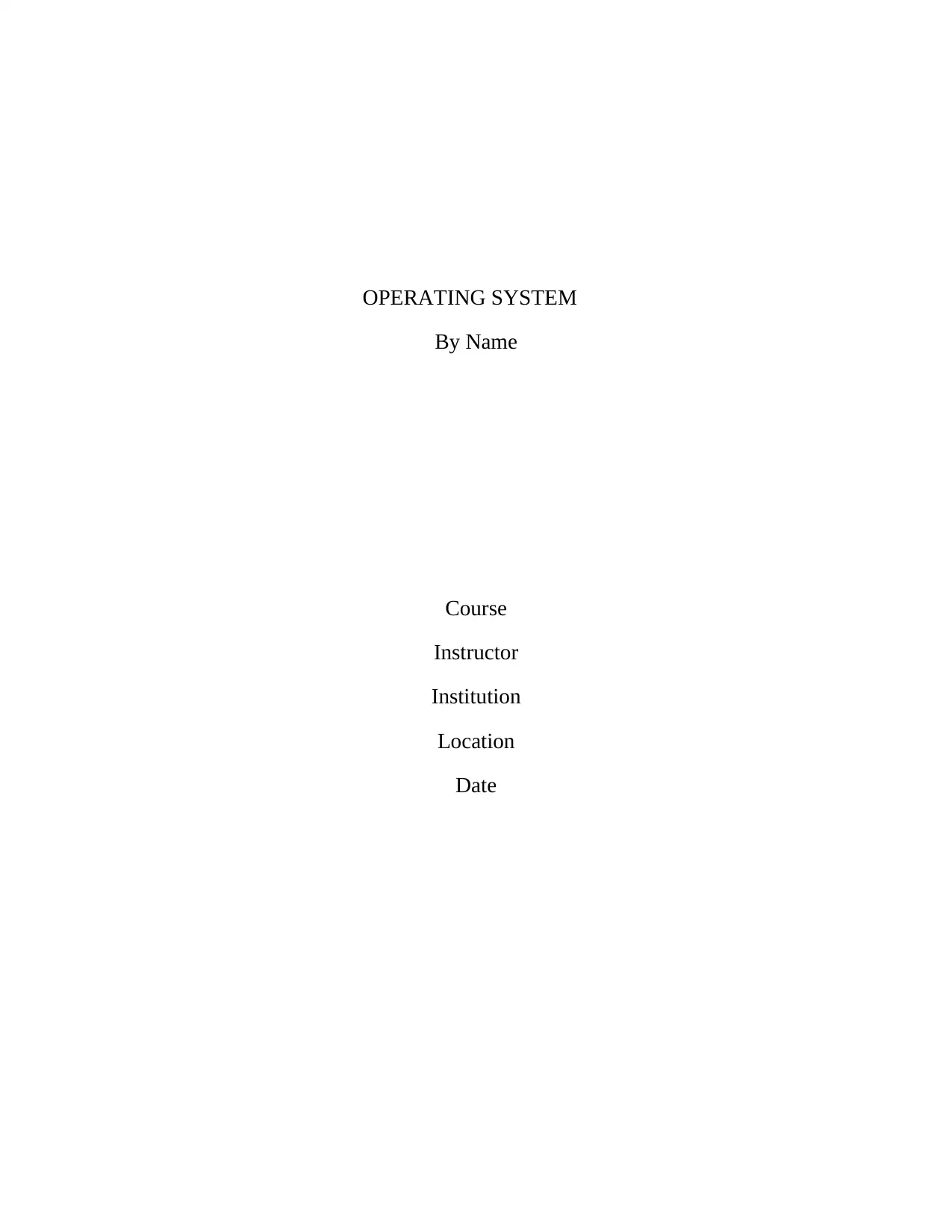
OPERATING SYSTEM
By Name
Course
Instructor
Institution
Location
Date
By Name
Course
Instructor
Institution
Location
Date
Paraphrase This Document
Need a fresh take? Get an instant paraphrase of this document with our AI Paraphraser
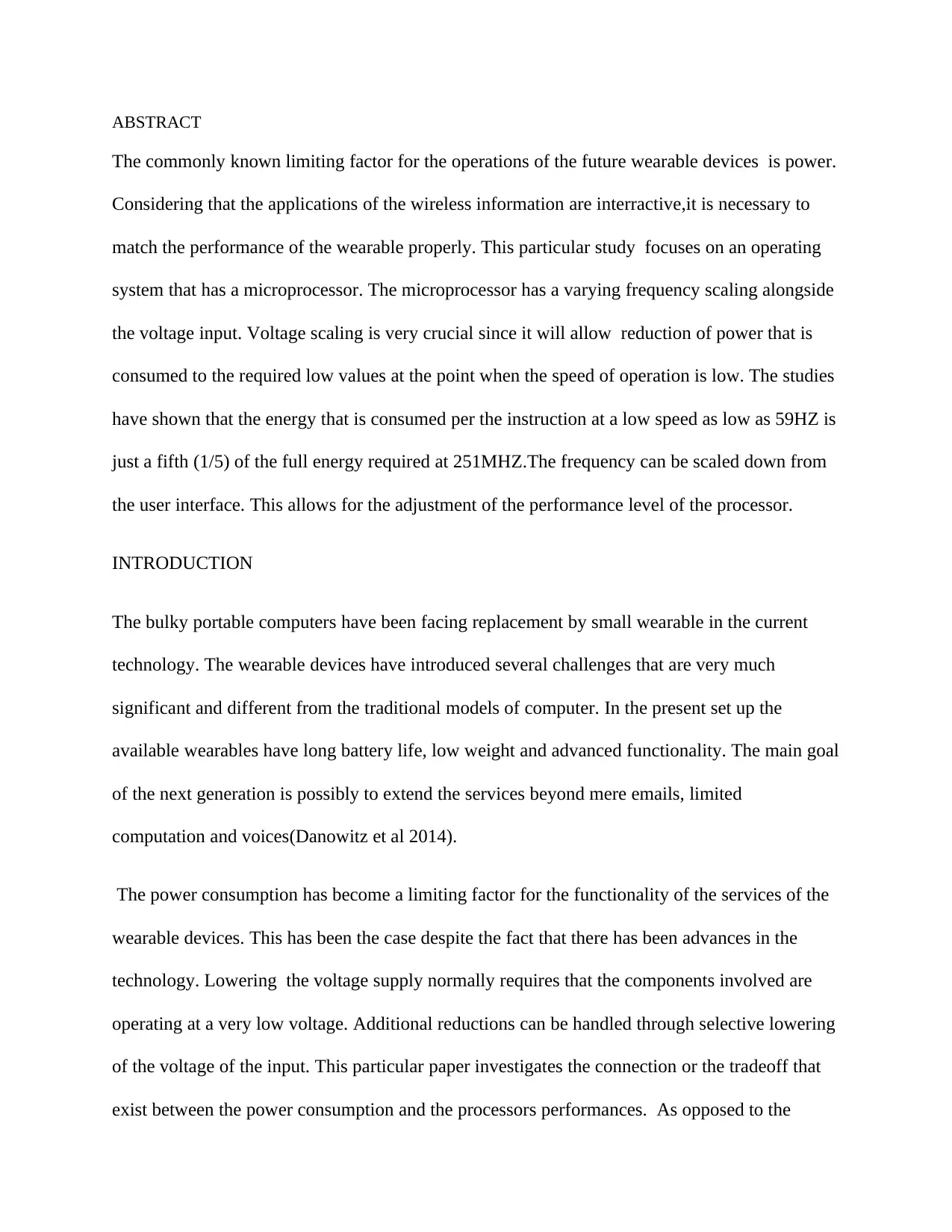
ABSTRACT
The commonly known limiting factor for the operations of the future wearable devices is power.
Considering that the applications of the wireless information are interractive,it is necessary to
match the performance of the wearable properly. This particular study focuses on an operating
system that has a microprocessor. The microprocessor has a varying frequency scaling alongside
the voltage input. Voltage scaling is very crucial since it will allow reduction of power that is
consumed to the required low values at the point when the speed of operation is low. The studies
have shown that the energy that is consumed per the instruction at a low speed as low as 59HZ is
just a fifth (1/5) of the full energy required at 251MHZ.The frequency can be scaled down from
the user interface. This allows for the adjustment of the performance level of the processor.
INTRODUCTION
The bulky portable computers have been facing replacement by small wearable in the current
technology. The wearable devices have introduced several challenges that are very much
significant and different from the traditional models of computer. In the present set up the
available wearables have long battery life, low weight and advanced functionality. The main goal
of the next generation is possibly to extend the services beyond mere emails, limited
computation and voices(Danowitz et al 2014).
The power consumption has become a limiting factor for the functionality of the services of the
wearable devices. This has been the case despite the fact that there has been advances in the
technology. Lowering the voltage supply normally requires that the components involved are
operating at a very low voltage. Additional reductions can be handled through selective lowering
of the voltage of the input. This particular paper investigates the connection or the tradeoff that
exist between the power consumption and the processors performances. As opposed to the
The commonly known limiting factor for the operations of the future wearable devices is power.
Considering that the applications of the wireless information are interractive,it is necessary to
match the performance of the wearable properly. This particular study focuses on an operating
system that has a microprocessor. The microprocessor has a varying frequency scaling alongside
the voltage input. Voltage scaling is very crucial since it will allow reduction of power that is
consumed to the required low values at the point when the speed of operation is low. The studies
have shown that the energy that is consumed per the instruction at a low speed as low as 59HZ is
just a fifth (1/5) of the full energy required at 251MHZ.The frequency can be scaled down from
the user interface. This allows for the adjustment of the performance level of the processor.
INTRODUCTION
The bulky portable computers have been facing replacement by small wearable in the current
technology. The wearable devices have introduced several challenges that are very much
significant and different from the traditional models of computer. In the present set up the
available wearables have long battery life, low weight and advanced functionality. The main goal
of the next generation is possibly to extend the services beyond mere emails, limited
computation and voices(Danowitz et al 2014).
The power consumption has become a limiting factor for the functionality of the services of the
wearable devices. This has been the case despite the fact that there has been advances in the
technology. Lowering the voltage supply normally requires that the components involved are
operating at a very low voltage. Additional reductions can be handled through selective lowering
of the voltage of the input. This particular paper investigates the connection or the tradeoff that
exist between the power consumption and the processors performances. As opposed to the
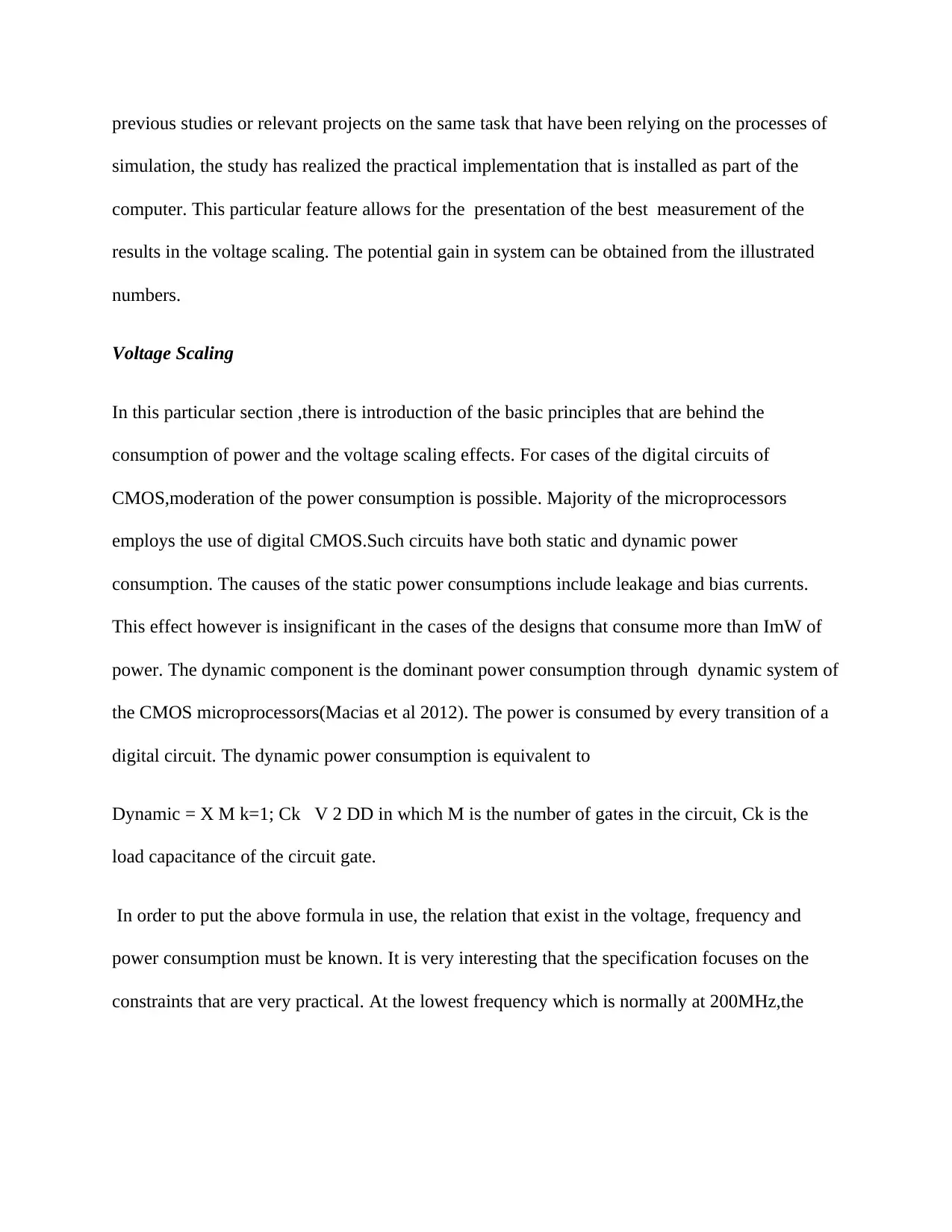
previous studies or relevant projects on the same task that have been relying on the processes of
simulation, the study has realized the practical implementation that is installed as part of the
computer. This particular feature allows for the presentation of the best measurement of the
results in the voltage scaling. The potential gain in system can be obtained from the illustrated
numbers.
Voltage Scaling
In this particular section ,there is introduction of the basic principles that are behind the
consumption of power and the voltage scaling effects. For cases of the digital circuits of
CMOS,moderation of the power consumption is possible. Majority of the microprocessors
employs the use of digital CMOS.Such circuits have both static and dynamic power
consumption. The causes of the static power consumptions include leakage and bias currents.
This effect however is insignificant in the cases of the designs that consume more than ImW of
power. The dynamic component is the dominant power consumption through dynamic system of
the CMOS microprocessors(Macias et al 2012). The power is consumed by every transition of a
digital circuit. The dynamic power consumption is equivalent to
Dynamic = X M k=1; Ck V 2 DD in which M is the number of gates in the circuit, Ck is the
load capacitance of the circuit gate.
In order to put the above formula in use, the relation that exist in the voltage, frequency and
power consumption must be known. It is very interesting that the specification focuses on the
constraints that are very practical. At the lowest frequency which is normally at 200MHz,the
simulation, the study has realized the practical implementation that is installed as part of the
computer. This particular feature allows for the presentation of the best measurement of the
results in the voltage scaling. The potential gain in system can be obtained from the illustrated
numbers.
Voltage Scaling
In this particular section ,there is introduction of the basic principles that are behind the
consumption of power and the voltage scaling effects. For cases of the digital circuits of
CMOS,moderation of the power consumption is possible. Majority of the microprocessors
employs the use of digital CMOS.Such circuits have both static and dynamic power
consumption. The causes of the static power consumptions include leakage and bias currents.
This effect however is insignificant in the cases of the designs that consume more than ImW of
power. The dynamic component is the dominant power consumption through dynamic system of
the CMOS microprocessors(Macias et al 2012). The power is consumed by every transition of a
digital circuit. The dynamic power consumption is equivalent to
Dynamic = X M k=1; Ck V 2 DD in which M is the number of gates in the circuit, Ck is the
load capacitance of the circuit gate.
In order to put the above formula in use, the relation that exist in the voltage, frequency and
power consumption must be known. It is very interesting that the specification focuses on the
constraints that are very practical. At the lowest frequency which is normally at 200MHz,the
⊘ This is a preview!⊘
Do you want full access?
Subscribe today to unlock all pages.

Trusted by 1+ million students worldwide
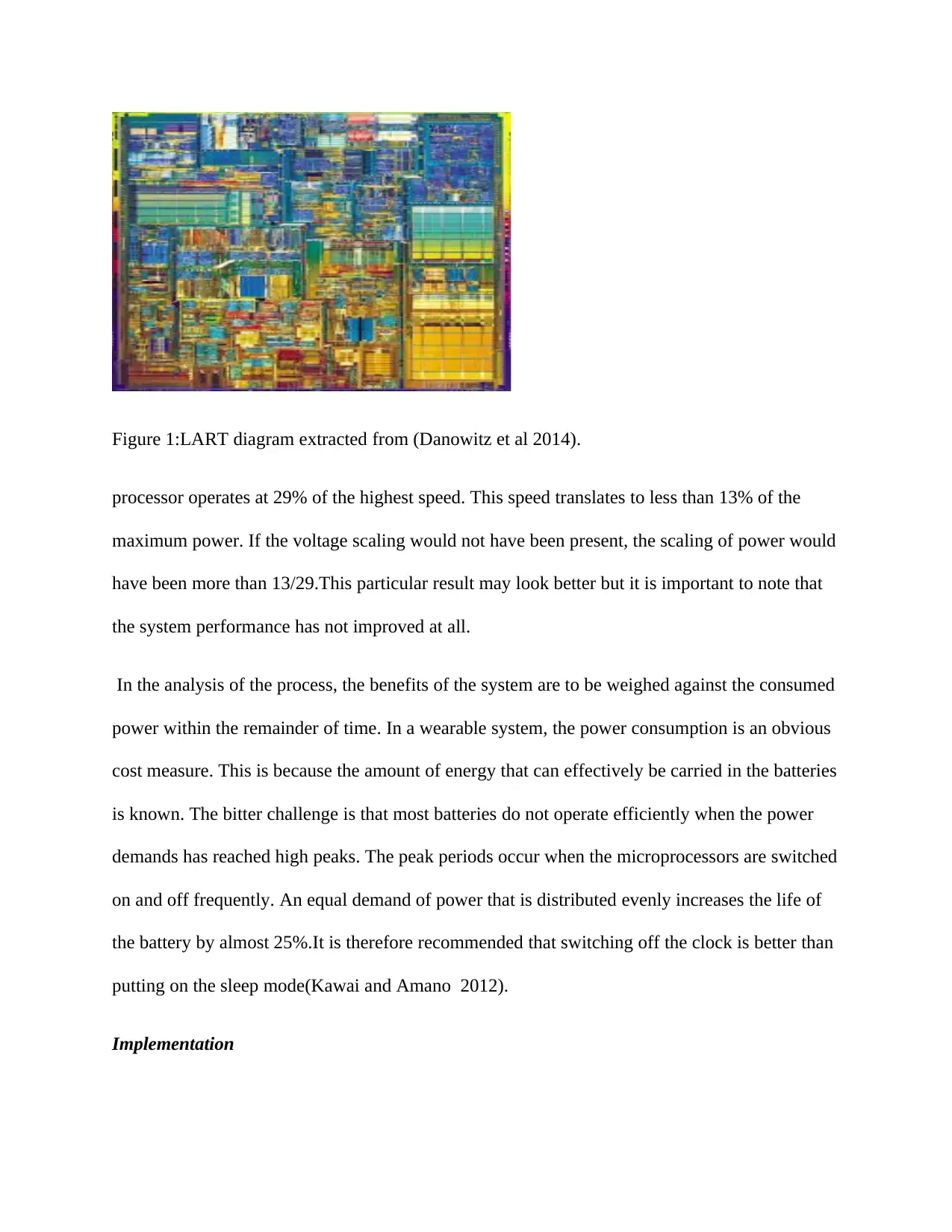
Figure 1:LART diagram extracted from (Danowitz et al 2014).
processor operates at 29% of the highest speed. This speed translates to less than 13% of the
maximum power. If the voltage scaling would not have been present, the scaling of power would
have been more than 13/29.This particular result may look better but it is important to note that
the system performance has not improved at all.
In the analysis of the process, the benefits of the system are to be weighed against the consumed
power within the remainder of time. In a wearable system, the power consumption is an obvious
cost measure. This is because the amount of energy that can effectively be carried in the batteries
is known. The bitter challenge is that most batteries do not operate efficiently when the power
demands has reached high peaks. The peak periods occur when the microprocessors are switched
on and off frequently. An equal demand of power that is distributed evenly increases the life of
the battery by almost 25%.It is therefore recommended that switching off the clock is better than
putting on the sleep mode(Kawai and Amano 2012).
Implementation
processor operates at 29% of the highest speed. This speed translates to less than 13% of the
maximum power. If the voltage scaling would not have been present, the scaling of power would
have been more than 13/29.This particular result may look better but it is important to note that
the system performance has not improved at all.
In the analysis of the process, the benefits of the system are to be weighed against the consumed
power within the remainder of time. In a wearable system, the power consumption is an obvious
cost measure. This is because the amount of energy that can effectively be carried in the batteries
is known. The bitter challenge is that most batteries do not operate efficiently when the power
demands has reached high peaks. The peak periods occur when the microprocessors are switched
on and off frequently. An equal demand of power that is distributed evenly increases the life of
the battery by almost 25%.It is therefore recommended that switching off the clock is better than
putting on the sleep mode(Kawai and Amano 2012).
Implementation
Paraphrase This Document
Need a fresh take? Get an instant paraphrase of this document with our AI Paraphraser
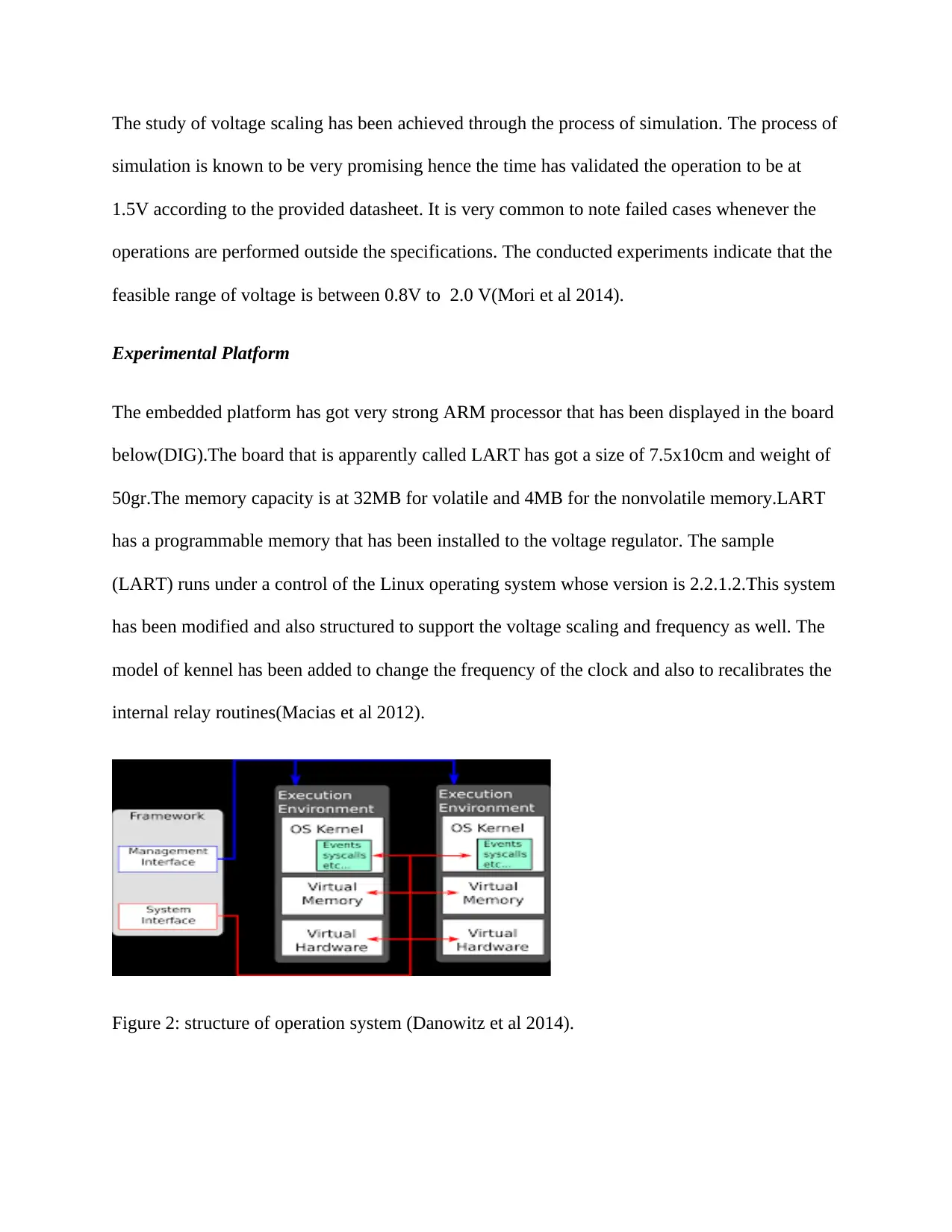
The study of voltage scaling has been achieved through the process of simulation. The process of
simulation is known to be very promising hence the time has validated the operation to be at
1.5V according to the provided datasheet. It is very common to note failed cases whenever the
operations are performed outside the specifications. The conducted experiments indicate that the
feasible range of voltage is between 0.8V to 2.0 V(Mori et al 2014).
Experimental Platform
The embedded platform has got very strong ARM processor that has been displayed in the board
below(DIG).The board that is apparently called LART has got a size of 7.5x10cm and weight of
50gr.The memory capacity is at 32MB for volatile and 4MB for the nonvolatile memory.LART
has a programmable memory that has been installed to the voltage regulator. The sample
(LART) runs under a control of the Linux operating system whose version is 2.2.1.2.This system
has been modified and also structured to support the voltage scaling and frequency as well. The
model of kennel has been added to change the frequency of the clock and also to recalibrates the
internal relay routines(Macias et al 2012).
Figure 2: structure of operation system (Danowitz et al 2014).
simulation is known to be very promising hence the time has validated the operation to be at
1.5V according to the provided datasheet. It is very common to note failed cases whenever the
operations are performed outside the specifications. The conducted experiments indicate that the
feasible range of voltage is between 0.8V to 2.0 V(Mori et al 2014).
Experimental Platform
The embedded platform has got very strong ARM processor that has been displayed in the board
below(DIG).The board that is apparently called LART has got a size of 7.5x10cm and weight of
50gr.The memory capacity is at 32MB for volatile and 4MB for the nonvolatile memory.LART
has a programmable memory that has been installed to the voltage regulator. The sample
(LART) runs under a control of the Linux operating system whose version is 2.2.1.2.This system
has been modified and also structured to support the voltage scaling and frequency as well. The
model of kennel has been added to change the frequency of the clock and also to recalibrates the
internal relay routines(Macias et al 2012).
Figure 2: structure of operation system (Danowitz et al 2014).
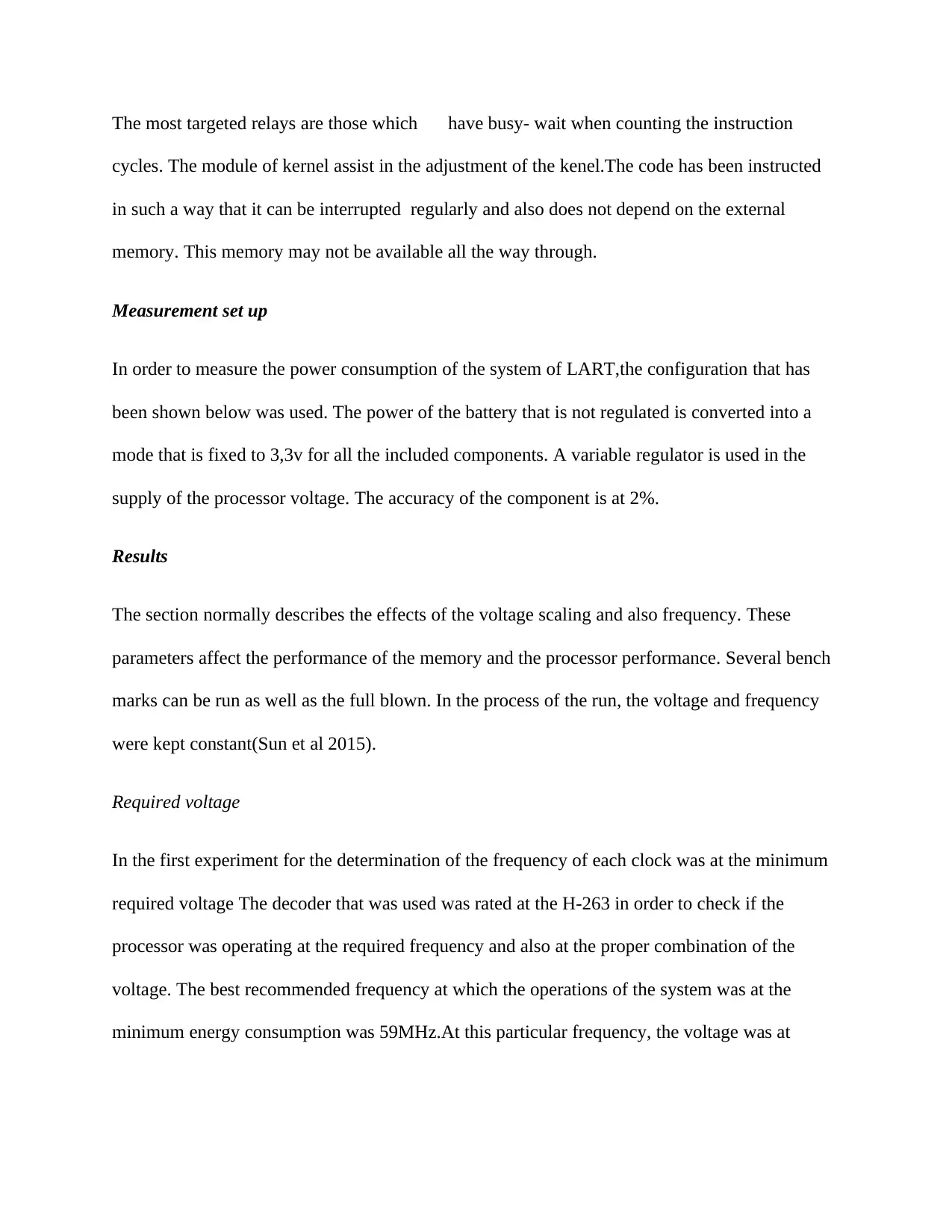
The most targeted relays are those which have busy- wait when counting the instruction
cycles. The module of kernel assist in the adjustment of the kenel.The code has been instructed
in such a way that it can be interrupted regularly and also does not depend on the external
memory. This memory may not be available all the way through.
Measurement set up
In order to measure the power consumption of the system of LART,the configuration that has
been shown below was used. The power of the battery that is not regulated is converted into a
mode that is fixed to 3,3v for all the included components. A variable regulator is used in the
supply of the processor voltage. The accuracy of the component is at 2%.
Results
The section normally describes the effects of the voltage scaling and also frequency. These
parameters affect the performance of the memory and the processor performance. Several bench
marks can be run as well as the full blown. In the process of the run, the voltage and frequency
were kept constant(Sun et al 2015).
Required voltage
In the first experiment for the determination of the frequency of each clock was at the minimum
required voltage The decoder that was used was rated at the H-263 in order to check if the
processor was operating at the required frequency and also at the proper combination of the
voltage. The best recommended frequency at which the operations of the system was at the
minimum energy consumption was 59MHz.At this particular frequency, the voltage was at
cycles. The module of kernel assist in the adjustment of the kenel.The code has been instructed
in such a way that it can be interrupted regularly and also does not depend on the external
memory. This memory may not be available all the way through.
Measurement set up
In order to measure the power consumption of the system of LART,the configuration that has
been shown below was used. The power of the battery that is not regulated is converted into a
mode that is fixed to 3,3v for all the included components. A variable regulator is used in the
supply of the processor voltage. The accuracy of the component is at 2%.
Results
The section normally describes the effects of the voltage scaling and also frequency. These
parameters affect the performance of the memory and the processor performance. Several bench
marks can be run as well as the full blown. In the process of the run, the voltage and frequency
were kept constant(Sun et al 2015).
Required voltage
In the first experiment for the determination of the frequency of each clock was at the minimum
required voltage The decoder that was used was rated at the H-263 in order to check if the
processor was operating at the required frequency and also at the proper combination of the
voltage. The best recommended frequency at which the operations of the system was at the
minimum energy consumption was 59MHz.At this particular frequency, the voltage was at
⊘ This is a preview!⊘
Do you want full access?
Subscribe today to unlock all pages.

Trusted by 1+ million students worldwide
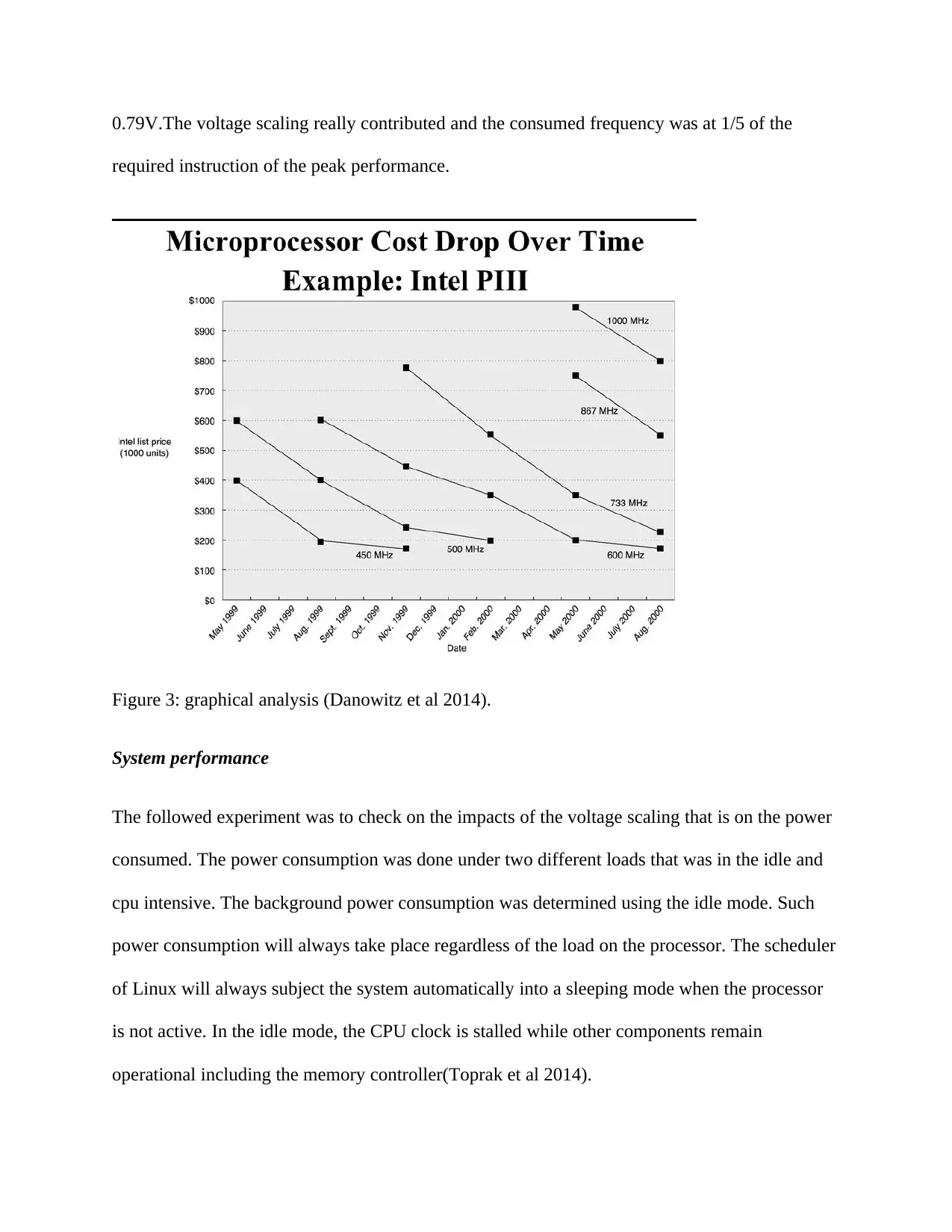
0.79V.The voltage scaling really contributed and the consumed frequency was at 1/5 of the
required instruction of the peak performance.
Figure 3: graphical analysis (Danowitz et al 2014).
System performance
The followed experiment was to check on the impacts of the voltage scaling that is on the power
consumed. The power consumption was done under two different loads that was in the idle and
cpu intensive. The background power consumption was determined using the idle mode. Such
power consumption will always take place regardless of the load on the processor. The scheduler
of Linux will always subject the system automatically into a sleeping mode when the processor
is not active. In the idle mode, the CPU clock is stalled while other components remain
operational including the memory controller(Toprak et al 2014).
required instruction of the peak performance.
Figure 3: graphical analysis (Danowitz et al 2014).
System performance
The followed experiment was to check on the impacts of the voltage scaling that is on the power
consumed. The power consumption was done under two different loads that was in the idle and
cpu intensive. The background power consumption was determined using the idle mode. Such
power consumption will always take place regardless of the load on the processor. The scheduler
of Linux will always subject the system automatically into a sleeping mode when the processor
is not active. In the idle mode, the CPU clock is stalled while other components remain
operational including the memory controller(Toprak et al 2014).
Paraphrase This Document
Need a fresh take? Get an instant paraphrase of this document with our AI Paraphraser
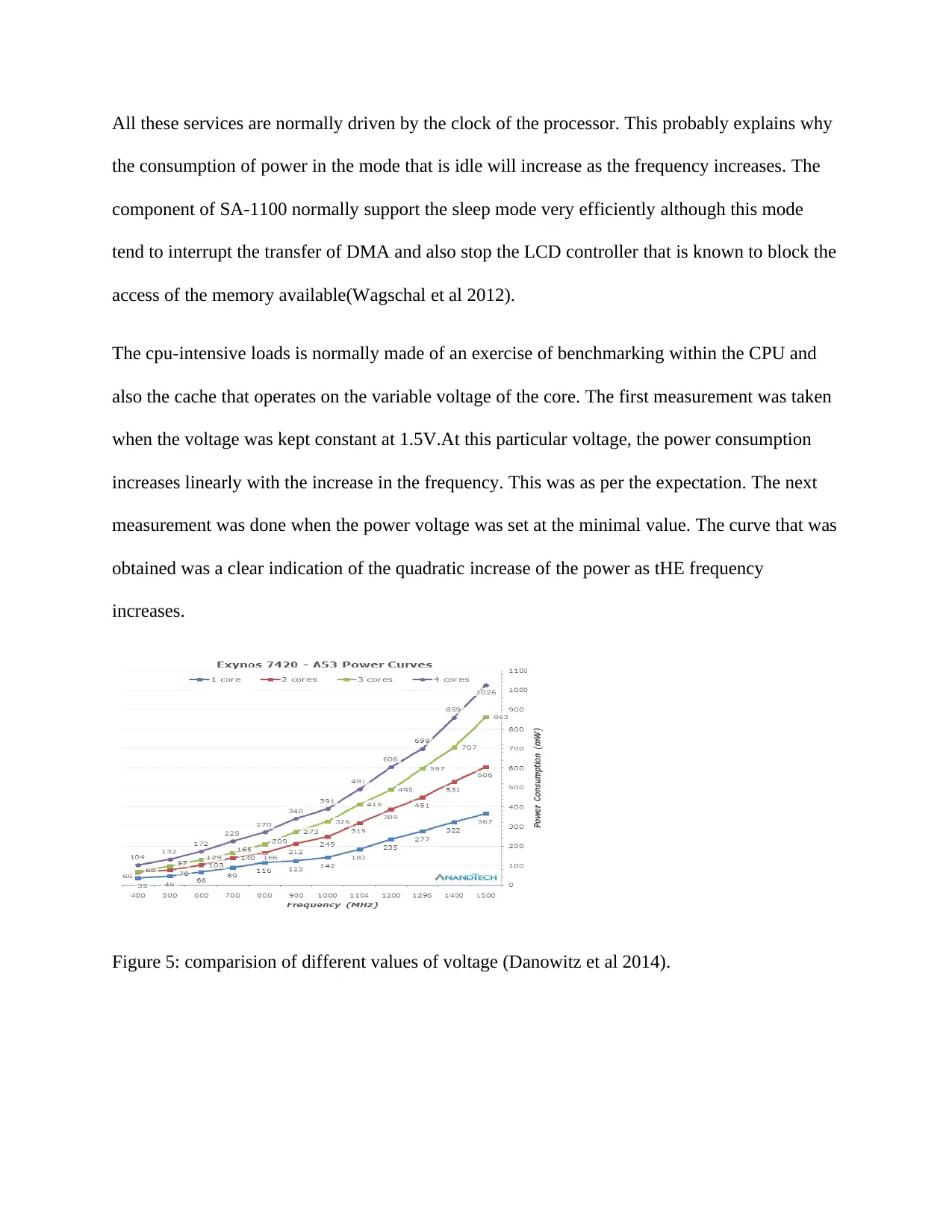
All these services are normally driven by the clock of the processor. This probably explains why
the consumption of power in the mode that is idle will increase as the frequency increases. The
component of SA-1100 normally support the sleep mode very efficiently although this mode
tend to interrupt the transfer of DMA and also stop the LCD controller that is known to block the
access of the memory available(Wagschal et al 2012).
The cpu-intensive loads is normally made of an exercise of benchmarking within the CPU and
also the cache that operates on the variable voltage of the core. The first measurement was taken
when the voltage was kept constant at 1.5V.At this particular voltage, the power consumption
increases linearly with the increase in the frequency. This was as per the expectation. The next
measurement was done when the power voltage was set at the minimal value. The curve that was
obtained was a clear indication of the quadratic increase of the power as tHE frequency
increases.
Figure 5: comparision of different values of voltage (Danowitz et al 2014).
the consumption of power in the mode that is idle will increase as the frequency increases. The
component of SA-1100 normally support the sleep mode very efficiently although this mode
tend to interrupt the transfer of DMA and also stop the LCD controller that is known to block the
access of the memory available(Wagschal et al 2012).
The cpu-intensive loads is normally made of an exercise of benchmarking within the CPU and
also the cache that operates on the variable voltage of the core. The first measurement was taken
when the voltage was kept constant at 1.5V.At this particular voltage, the power consumption
increases linearly with the increase in the frequency. This was as per the expectation. The next
measurement was done when the power voltage was set at the minimal value. The curve that was
obtained was a clear indication of the quadratic increase of the power as tHE frequency
increases.
Figure 5: comparision of different values of voltage (Danowitz et al 2014).
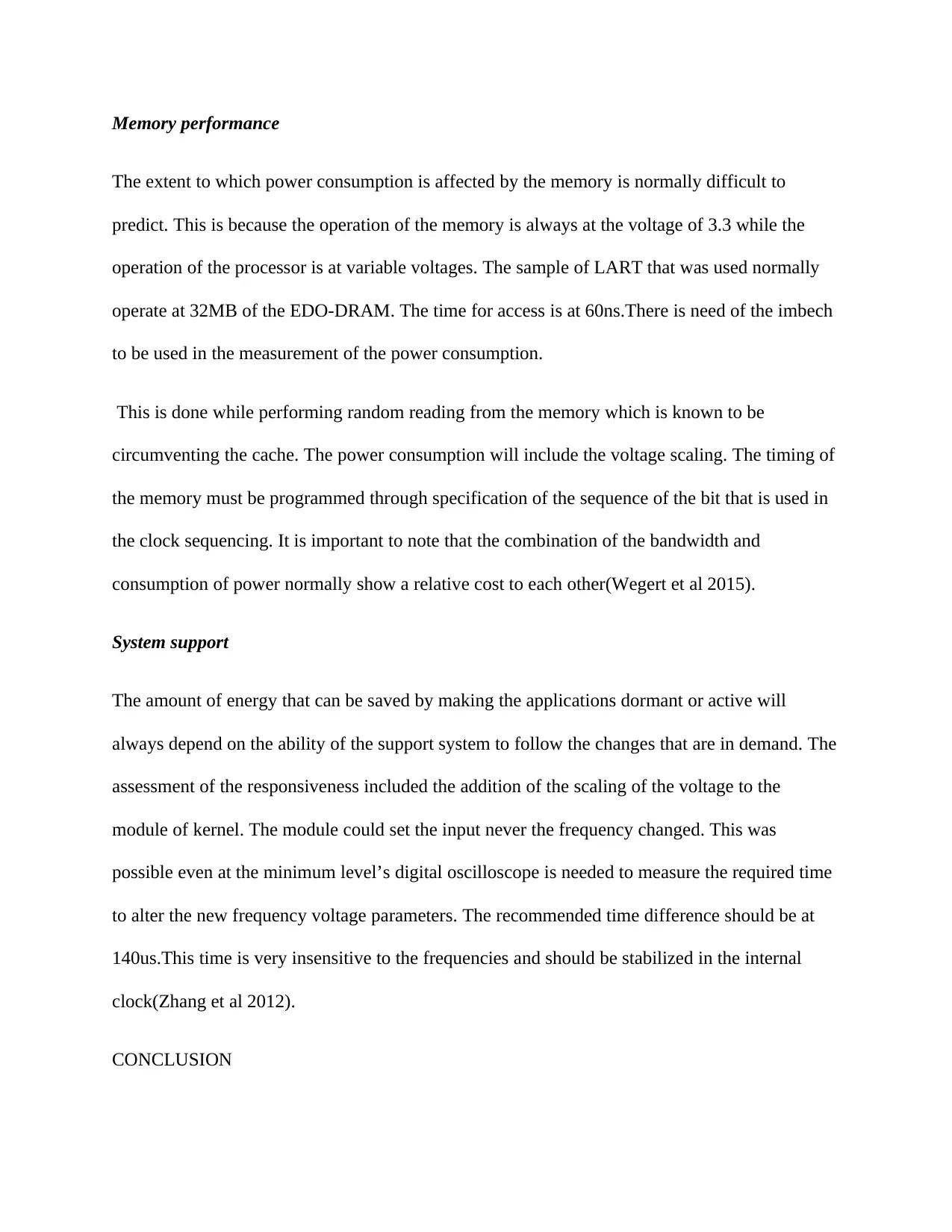
Memory performance
The extent to which power consumption is affected by the memory is normally difficult to
predict. This is because the operation of the memory is always at the voltage of 3.3 while the
operation of the processor is at variable voltages. The sample of LART that was used normally
operate at 32MB of the EDO-DRAM. The time for access is at 60ns.There is need of the imbech
to be used in the measurement of the power consumption.
This is done while performing random reading from the memory which is known to be
circumventing the cache. The power consumption will include the voltage scaling. The timing of
the memory must be programmed through specification of the sequence of the bit that is used in
the clock sequencing. It is important to note that the combination of the bandwidth and
consumption of power normally show a relative cost to each other(Wegert et al 2015).
System support
The amount of energy that can be saved by making the applications dormant or active will
always depend on the ability of the support system to follow the changes that are in demand. The
assessment of the responsiveness included the addition of the scaling of the voltage to the
module of kernel. The module could set the input never the frequency changed. This was
possible even at the minimum level’s digital oscilloscope is needed to measure the required time
to alter the new frequency voltage parameters. The recommended time difference should be at
140us.This time is very insensitive to the frequencies and should be stabilized in the internal
clock(Zhang et al 2012).
CONCLUSION
The extent to which power consumption is affected by the memory is normally difficult to
predict. This is because the operation of the memory is always at the voltage of 3.3 while the
operation of the processor is at variable voltages. The sample of LART that was used normally
operate at 32MB of the EDO-DRAM. The time for access is at 60ns.There is need of the imbech
to be used in the measurement of the power consumption.
This is done while performing random reading from the memory which is known to be
circumventing the cache. The power consumption will include the voltage scaling. The timing of
the memory must be programmed through specification of the sequence of the bit that is used in
the clock sequencing. It is important to note that the combination of the bandwidth and
consumption of power normally show a relative cost to each other(Wegert et al 2015).
System support
The amount of energy that can be saved by making the applications dormant or active will
always depend on the ability of the support system to follow the changes that are in demand. The
assessment of the responsiveness included the addition of the scaling of the voltage to the
module of kernel. The module could set the input never the frequency changed. This was
possible even at the minimum level’s digital oscilloscope is needed to measure the required time
to alter the new frequency voltage parameters. The recommended time difference should be at
140us.This time is very insensitive to the frequencies and should be stabilized in the internal
clock(Zhang et al 2012).
CONCLUSION
⊘ This is a preview!⊘
Do you want full access?
Subscribe today to unlock all pages.

Trusted by 1+ million students worldwide
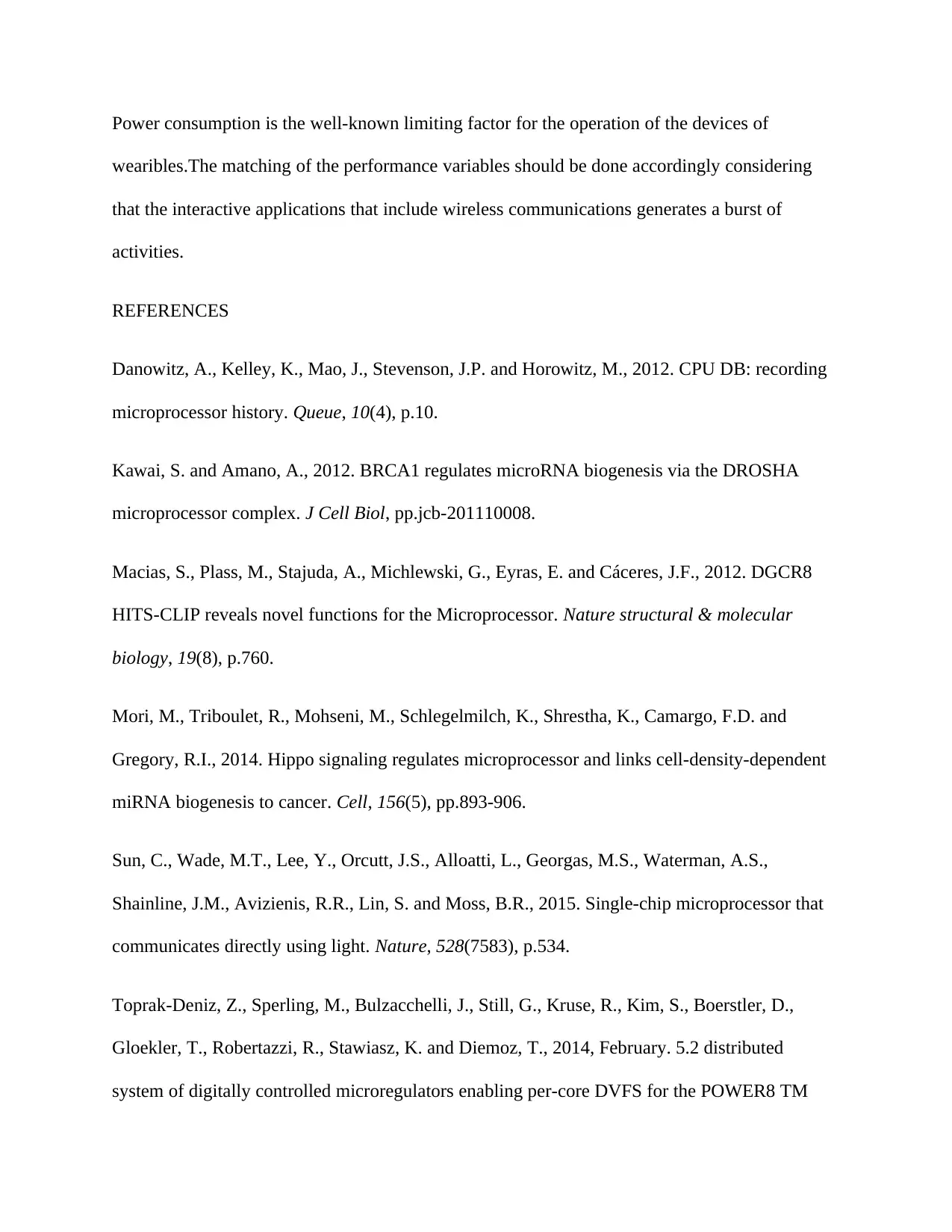
Power consumption is the well-known limiting factor for the operation of the devices of
wearibles.The matching of the performance variables should be done accordingly considering
that the interactive applications that include wireless communications generates a burst of
activities.
REFERENCES
Danowitz, A., Kelley, K., Mao, J., Stevenson, J.P. and Horowitz, M., 2012. CPU DB: recording
microprocessor history. Queue, 10(4), p.10.
Kawai, S. and Amano, A., 2012. BRCA1 regulates microRNA biogenesis via the DROSHA
microprocessor complex. J Cell Biol, pp.jcb-201110008.
Macias, S., Plass, M., Stajuda, A., Michlewski, G., Eyras, E. and Cáceres, J.F., 2012. DGCR8
HITS-CLIP reveals novel functions for the Microprocessor. Nature structural & molecular
biology, 19(8), p.760.
Mori, M., Triboulet, R., Mohseni, M., Schlegelmilch, K., Shrestha, K., Camargo, F.D. and
Gregory, R.I., 2014. Hippo signaling regulates microprocessor and links cell-density-dependent
miRNA biogenesis to cancer. Cell, 156(5), pp.893-906.
Sun, C., Wade, M.T., Lee, Y., Orcutt, J.S., Alloatti, L., Georgas, M.S., Waterman, A.S.,
Shainline, J.M., Avizienis, R.R., Lin, S. and Moss, B.R., 2015. Single-chip microprocessor that
communicates directly using light. Nature, 528(7583), p.534.
Toprak-Deniz, Z., Sperling, M., Bulzacchelli, J., Still, G., Kruse, R., Kim, S., Boerstler, D.,
Gloekler, T., Robertazzi, R., Stawiasz, K. and Diemoz, T., 2014, February. 5.2 distributed
system of digitally controlled microregulators enabling per-core DVFS for the POWER8 TM
wearibles.The matching of the performance variables should be done accordingly considering
that the interactive applications that include wireless communications generates a burst of
activities.
REFERENCES
Danowitz, A., Kelley, K., Mao, J., Stevenson, J.P. and Horowitz, M., 2012. CPU DB: recording
microprocessor history. Queue, 10(4), p.10.
Kawai, S. and Amano, A., 2012. BRCA1 regulates microRNA biogenesis via the DROSHA
microprocessor complex. J Cell Biol, pp.jcb-201110008.
Macias, S., Plass, M., Stajuda, A., Michlewski, G., Eyras, E. and Cáceres, J.F., 2012. DGCR8
HITS-CLIP reveals novel functions for the Microprocessor. Nature structural & molecular
biology, 19(8), p.760.
Mori, M., Triboulet, R., Mohseni, M., Schlegelmilch, K., Shrestha, K., Camargo, F.D. and
Gregory, R.I., 2014. Hippo signaling regulates microprocessor and links cell-density-dependent
miRNA biogenesis to cancer. Cell, 156(5), pp.893-906.
Sun, C., Wade, M.T., Lee, Y., Orcutt, J.S., Alloatti, L., Georgas, M.S., Waterman, A.S.,
Shainline, J.M., Avizienis, R.R., Lin, S. and Moss, B.R., 2015. Single-chip microprocessor that
communicates directly using light. Nature, 528(7583), p.534.
Toprak-Deniz, Z., Sperling, M., Bulzacchelli, J., Still, G., Kruse, R., Kim, S., Boerstler, D.,
Gloekler, T., Robertazzi, R., Stawiasz, K. and Diemoz, T., 2014, February. 5.2 distributed
system of digitally controlled microregulators enabling per-core DVFS for the POWER8 TM
Paraphrase This Document
Need a fresh take? Get an instant paraphrase of this document with our AI Paraphraser
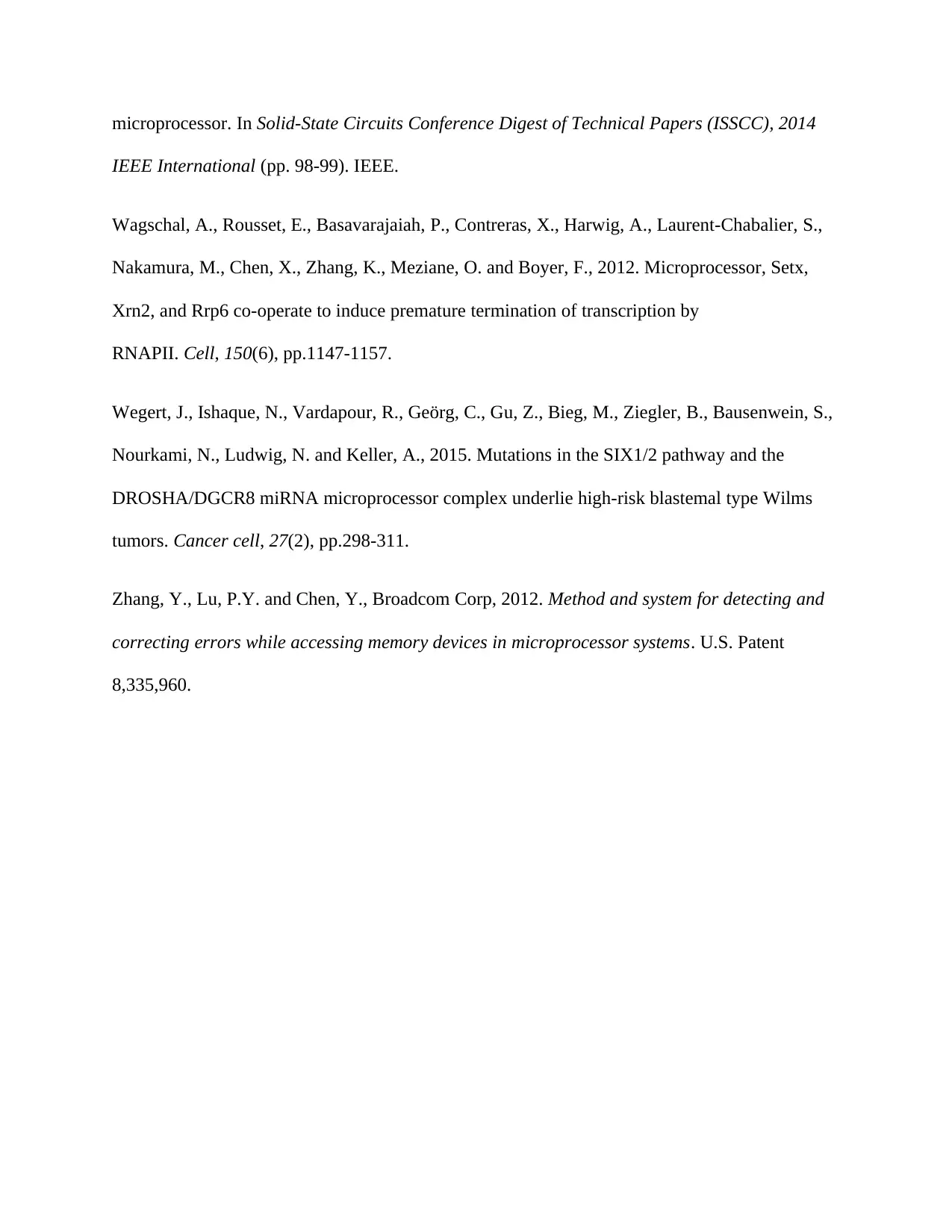
microprocessor. In Solid-State Circuits Conference Digest of Technical Papers (ISSCC), 2014
IEEE International (pp. 98-99). IEEE.
Wagschal, A., Rousset, E., Basavarajaiah, P., Contreras, X., Harwig, A., Laurent-Chabalier, S.,
Nakamura, M., Chen, X., Zhang, K., Meziane, O. and Boyer, F., 2012. Microprocessor, Setx,
Xrn2, and Rrp6 co-operate to induce premature termination of transcription by
RNAPII. Cell, 150(6), pp.1147-1157.
Wegert, J., Ishaque, N., Vardapour, R., Geörg, C., Gu, Z., Bieg, M., Ziegler, B., Bausenwein, S.,
Nourkami, N., Ludwig, N. and Keller, A., 2015. Mutations in the SIX1/2 pathway and the
DROSHA/DGCR8 miRNA microprocessor complex underlie high-risk blastemal type Wilms
tumors. Cancer cell, 27(2), pp.298-311.
Zhang, Y., Lu, P.Y. and Chen, Y., Broadcom Corp, 2012. Method and system for detecting and
correcting errors while accessing memory devices in microprocessor systems. U.S. Patent
8,335,960.
IEEE International (pp. 98-99). IEEE.
Wagschal, A., Rousset, E., Basavarajaiah, P., Contreras, X., Harwig, A., Laurent-Chabalier, S.,
Nakamura, M., Chen, X., Zhang, K., Meziane, O. and Boyer, F., 2012. Microprocessor, Setx,
Xrn2, and Rrp6 co-operate to induce premature termination of transcription by
RNAPII. Cell, 150(6), pp.1147-1157.
Wegert, J., Ishaque, N., Vardapour, R., Geörg, C., Gu, Z., Bieg, M., Ziegler, B., Bausenwein, S.,
Nourkami, N., Ludwig, N. and Keller, A., 2015. Mutations in the SIX1/2 pathway and the
DROSHA/DGCR8 miRNA microprocessor complex underlie high-risk blastemal type Wilms
tumors. Cancer cell, 27(2), pp.298-311.
Zhang, Y., Lu, P.Y. and Chen, Y., Broadcom Corp, 2012. Method and system for detecting and
correcting errors while accessing memory devices in microprocessor systems. U.S. Patent
8,335,960.
1 out of 11
Related Documents
Your All-in-One AI-Powered Toolkit for Academic Success.
+13062052269
info@desklib.com
Available 24*7 on WhatsApp / Email
![[object Object]](/_next/static/media/star-bottom.7253800d.svg)
Unlock your academic potential
Copyright © 2020–2025 A2Z Services. All Rights Reserved. Developed and managed by ZUCOL.





